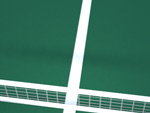Tennis

Grip
In tennis, a grip is a way of holding the racquet in order to hit shots during a match. The three most commonly used conventional grips are: the Continental (or "Chopper"), the Eastern and the Western. Most players change grips during a match depending on what shot they are hitting.
The octagonal handle
In order to understand the grips, it is important to know that the handle of a racquet always consists of 8 sides or, in other words, has an octagonal shape. A square shape would hurt the hand, while a round shape would not give enough friction to gain a firm grip. The eight sides of the handle are called bevels. We can number the bevels from 1 to 8 as follows: if the blade of the racquet is perpendicular to the ground, the bevel facing up is bevel #1. Rotating the racquet counter-clockwise (for a right handed player, clockwise for a left handed player), the next bevel facing up is bevel #2, if you are right-handed, and clockwise if you are left-handed, and so on to identify all 8 bevels.
The grips
The Continental Grip (Bevel #2)
The Continental grip, also called the Chopper grip or Hammer grip, is obtained when placing the hand such that the base knuckle of the index finger is right on bevel #2. It is naturally obtained when holding the racket as if it were an axe, hence the second name "Chopper grip". The Continental grip is suitable for a variety of shots and therefore is often taught to absolute beginners, so that they should not bother changing grips while learning the basics of the game. This type of grip is very useful for quick volleys and strokes near the net. Since modern tennis, especially clay-court tennis, has shown an evolution towards topspin, the Continental grip has gone out of fashion with professional players for hitting groundstrokes. It is still the preferred grip for serves and volleys. Additionally, the grip is used for some defensive strategies, such as chipping and blocking shots. Moreover, the grip can be used offensively to hit a "drop shot", which puts extreme backward spin on the ball. The rest of the grips strike a balance between high spin capacity on the one hand, and power on the other.
The Eastern Forehand Grip (Bevel #3)
The Eastern Forehand grip is obtained when placing the hand such that the base knuckle of the index finger is right on bevel #3. The Eastern Forehand grip allows for fast, flat shots on the forehand, with some control through topspin. Net players like it because it easily changes to the continental grip for volleys. It offers little control at high balls, and there is not enough control to sustain long rallies. It is also known as the shake hands grip.
The Semi-Western Forehand Grip (Bevel #4)
The Semi-Western grip is obtained by placing the hand such that the base knuckle of the index finger is right on bevel #4. This racquet grip is popular with baseliners who like to hit with much topspin and a ferocious amount of power. It gets more hand behind the grip, causing shots to result with more ferocity, and provides a contact point much farther out front. On the other hand it poses problems with lower balls, which are hard to catch with the (extreme) down-up movement required for the Semi-Western grip
The Western Forehand Grip (Bevel #5)
The Western grip is obtained by placing the hand such that the base knuckle of the index finger is right on bevel #5. This grip is used for applying extreme topspin, but is evenly hard to play. Low balls are extremely difficult to return.
The Double-Handed Forehand Grip (F: Bevel #2 + B: Bevel #6)
The basic Two-Handed Forehand grip, is obtained by holding the racquet in a regular Continental grip, then placing the left hand above holding it in a left-handed Semi-Western Forehand grip. This places the reference bevels of the two hands exactly opposite each other. Holding the racquet using two hands for the forehand is highly unusual, but some well-known top WTA players (e.g. Monica Seles) have used it successfully. While it shortens the forehand reach and reduces maximum power, it offers unrivalled accuracy, which may more than compensate the former drawbacks. Also, combined with a two-handed backhand, it is almost impossible for the opponent to see which side (backhand or forehand) is hitting the ball. The sides often are equally accurate, and no grip change is required.
The Eastern Backhand Grip (Bevel #1)
The Eastern Backhand grip is obtained when placing the hand such that the base knuckle of the index finger and heel of the hand are right on bevel #1. This grip allows for significant spin and control. The same face of the racquet as in the forehand is used to strike the ball. No need to change grips if the forehand is played with a Western grip.
The Semi-Western Backhand grip (Bevel #8)
The Semi-Western backhand grip, is used by placing the hand such that the base knuckle of the index finger is right on bevel #8. Compared to the Continental grip, the blade has rotated 90 degrees clockwise. This forces the wrist in an uncomfortable twist but allows for the greatest possible spin.
This is basically equivalent to the Semi-Western forehand grip. The same face of the racquet as in the forehand is used to strike the ball. No need to change grips if the forehand is played with a Semi-Western grip.
The Double-Handed Backhand Grip (F: Bevel #2 + B: Bevel #6)
The basic Two-Handed Backhand grip is obtained by holding the racquet in a regular Continental grip, then placing the left hand above holding it in a left-handed Semi-Western Forehand grip. This places the reference bevels of the two hands exactly opposite each other. Holding the racquet using two hands for the backhand is very common, but there are many variations in the precise positioning of the two hands. This also varies between right- and left-handed players.
A different face of the racquet than in the forehand is used to strike the ball.
The evolution of forehand grips
For a number of years during the first two decades of the 20th century the small, frail player Bill Johnston was considered by many to have had the best forehand of all time, a stroke that he hit shoulder-high using a Western grip. Few top players used the Western grip after the 1920s, but in the latter part of the 20th century, as shot-making techniques and equipment changed radically, the Western forehand made a strong comeback and is now used by many modern players. With the changes in technology, the various grips have come to be used very differently from previously. First, the Continental grip is used primarily to serve and to volley, not to hit forehand shots, or a backhand slice. The eastern grip is still used, though far less than in the past, and is used to hit very flat shots. It is excellent to hit low passing shots. The most popular grip on the tour is the Semi-Western grip. It gives a nice mix of spin and pace on the forehand, and offers ease to transition to the backhand grip. Finally the Western grip (and its extreme variations), are some of the most radical grips used on the tour, mostly by clay-courters, and are used to create massive amounts of topspin.
The evolution of backhand grips
The backhand can be executed with either one or both hands. For most of the 20th century it was performed with one hand, using either a backhand Eastern or Continental grip. In modern tennis, there are a few professional players who use a Western one-hand backhand. This shot is held in a similar manner to the Eastern forehand. It has much more topspin potential than the traditional Eastern one-hander. The Western one-handed backhand grip makes it easier for a one-handed player to hit balls at shoulder height, but harder to hit low balls, and vice versa for the eastern one-handed backhand. The eastern one-handed backhand and its variants are used by most pros with strong single-handed backhand drives, like Gustavo Kuerten, especially Richard Gasquet among the men, and Justine Henin among the women.
The two-handed backhand is most commonly used with the forehand hand holding the racquet with a Continental grip and the non-dominant hand holding the racquet with an Semi-western forehand grip. While this is by far the most common way to hit a two-handed backhand, there are players who use different ways of holding the racquet for a two-handed backhand.
The player long considered to have had the best backhand of all time, Don Budge, had a very powerful one-handed stroke in the 1930s and 1940s that imparted topspin onto the ball. Ken Rosewall, a one-handed backhand, used a tremendously accurate slice backhand with underspin through the 1950s and 1960s. The one-handed backhand slice is often used in rallies as it is a comfortable shot. Andre Agassi in particular increased his use of the one-handed backhand and often hit an unreturnable dropshot with it.
Grips used for serving
The grip for the serve depends on the type of serve. At professional levels, the top spin serve is hit with an Eastern backhand grip (bevel #1). The server stands at an angle to the baseline, so that he can turn during the service and make contact with the racquet squarely on the ball.
At professional levels, the slice serve is most commonly hit with a Continental grip (bevel #2). The server tosses the ball a little to the right of his body (if he is right-handed) and cuts the ball at the side to impart spin. For a right-hander, the slice serve curves to the left, and is useful in pulling the opponent out wide, or serving into his body. Many players, however, use an Eastern backhand grip (bevel #1) for their spin serves; this gives the racquet even more angle as it sweeps across the ball.
There are three types of kick (topspin) serves; the pure topspin serve, the topspin-slice serve, and the twist serve. For most, the topspin serve is hit by using an Eastern backhand grip (bevel #1) and the ball is thrown so that if it were to drop, it would land on the server's heel or head. In the topspin serve, the racquet brushes up the backside the ball to impart topspin. In the topspin-slice or kick serve, the racquet is held with an Eastern backhand or Continental grip. The topspin-slice serve has both topspin and slice, and, when hit correctly, bounces in the opposite direction from the slice serve. An extreme serve requiring flexibility and a strong back, the American twist, is where one tosses the ball usually very far off to the left (for right-handed players) and imparts spin going the opposite direction of a topspin-slice serve. All of these serves are used to make an effective serve that nevertheless has a high safety factor because they clear the net with a relatively high margin of space and use the topspin to pull the ball down into the service box.
SPORTS

RESOURCES
This article uses material from the Wikipedia articles "Tennis" and "Grip (tennis)", which is released under the Creative Commons Attribution-Share-Alike License 3.0.
© Stories Preschool. All Rights Reserved.









